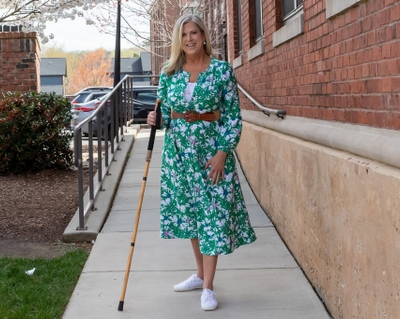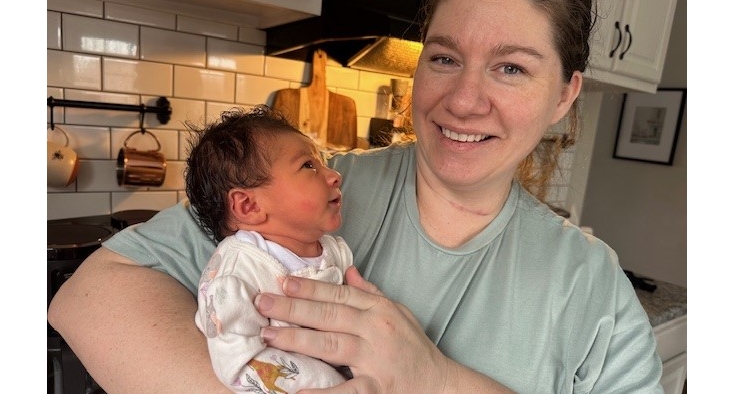When writing your online dating profile, you want to put your best foot forward. But for Betsy Patton, this didn't feel possible.
After healing from divorce, the 53-year-old was ready to meet someone new — but physically, she was falling apart.
She wanted to write about her love of tennis and desire to take long walks together. But at the time, she couldn’t safely walk across a room.
“I don’t want to be dishonest and say, ‘I’m fine,’” Patton said. “As soon as they see me walk up, they'd know.”
Patton’s challenges started with sciatic pain in late 2022. Then, the Charlotte resident developed “drop foot” – the inability to raise the front part of her right foot – causing her to walk with a limp even after medication and surgery. In summer 2023, she had emergency colon surgery and wound up in the hospital three times with complications. She hoped 2024 would be a fresh start – but instead, her neck began hurting and she began to lose balance in her left foot, too.
Along the way, Patton paused her quest for love.
“I don't want to be alone the rest of my life,” Patton said. “But I haven't been able to trust or commit. Meeting somebody new is hard when I have all this going on.”
Complete neurological care.
Dating wasn't her only concern. Patton loved her job as an executive assistant at a financial services company, but her health issues had started impacting her work. Although her coworkers have been extremely supportive, Patton said, “Over the last two years, they’ve watched how I've gone from being very energetic, able to do my job, able to run around and do my thing, to hardly being able to even walk at all.”
Her previous care had been outside of Novant Health, but in 2024, she began seeing Novant Health specialists, who ordered MRIs on Patton’s back and neck. The medical team identified an unusual neck curvature that was compressing her spinal cord and nerves. They also ordered bloodwork that identified markers for an autoimmune disease, which they thought was likely complicating things, so the team referred Patton to a rheumatologist.
The rheumatologist diagnosed her with lupus and started her on medication.
Patton expected her symptoms to disappear with the medication. Instead, her balance became worse over time, and she started losing strength and mobility in her hands and fingers. On her own, Patton discontinued the lupus medication and visited additional doctors, “just trying to figure out what's going on with me,” Patton said. “Somebody's got to tell me something.” But no one could explain what was happening.

Her symptoms were getting worse each week, so Patton called Novant Health Spine Specialists - Randolph Road again and asked to be seen “ASAP.” Just three days later, she saw the practice's newest neurosurgeon: Dr. Kelly Ryan Wackerle.
By this point, Patton could no longer go to her office, and she was losing her ability to type. She couldn't grip a fork, fasten her pants or lift her arms up to wash or blow dry her hair. She leaned on walls for balance and was starting to have difficulty controlling her bladder.
“Dr. Wackerle saw that it was a big deal,” Patton said. “She immediately showed concern and did not downplay my emotions. She took into account that I am a woman, I am single, I need to have a life, I need to work.”
Wackerle diagnosed Patton with advanced cervical myelopathy – compression of the spinal cord with evidence of spinal cord damage on her exam. Because of Patton’s curved neck, her lupus, and "normal wear and tear over time,” her spinal cord was compressed “at many levels of her cervical spine,” Wackerle said.
Patton had been right: She needed help, “ASAP.”
Given the timing and course of Patton’s symptoms, Wackerle couldn’t guarantee that surgery would reverse the damage Patton had already endured, but without taking pressure off her spine with surgery, she’d keep getting worse.
And Wackerle was clear about one more thing: Surgery was risky. The surgery not only involved taking pressure off her spine, but also involved “reversing” the curvature of her neck. If Patton decided to undergo urgent surgery, they both needed a strong team around them.
Patton would need to better control her lupus and get her three children in their 20s to support her after the operation. And Wackerle would assemble a team to help her plan and implement the safest surgery possible.
Patton cried for 48 hours, then decided: She was in. “My kids are young,” Patton said. “I want them to live their life, not take care of me for the rest of my life.”
By their next meeting, “Dr. Wackerle had already met with several other physicians and had created a whole team that would perform the surgery,” Patton said. “She already had a plan.”
A personalized surgical plan
Spinal surgery isn't one-size-fits-all.
“You have to consider all the various factors of the patient: past surgeries, current medical problems, the anatomy on the imaging, and making sure that the plan aligns with fixing their symptoms and pain. Trying to bring all that together in the way that makes the most sense for each patient requires a very personalized surgical plan for each patient,” Wackerle said. “Part of what's nice about being at Novant Health is that the spine surgeons will collaborate and make sure that the person who is the best at each case is involved in the care of the patient – and sometimes that means more than one surgeon for the complex cases.”
A team approach to complex surgeries
Novant Health emphasizes collaboration across specialties – “trying to get all the right people on a team to care for the patient,” as neurosurgeon Dr. Kelly Ryan Wackerle puts it.
Wackerle said surgeons often consult with other specialists or surgeons, especially when a patient has multiple health issues or challenging pathology. They talk big picture: Is the patient medically healthy enough for surgery? What type of surgery best addresses this patient’s needs and anatomy?
And they talk details: “What types of screws, what type of spacers we use, what type of bone products or not we put into our spine surgeries to make sure they fuse and heal … there’s hundreds of decisions that go into one spine surgery, especially the complex ones,” Wackerle said.
Autoimmune diseases can make surgery more dangerous, so Wackerle worked with Patton’s rheumatologist to get Patton healthy enough for surgery. She also consulted with other specialists to make sure the surgical plan addressed the risks of Patton's lupus.
The team decided the best option was to perform a multilevel anterior cervical discectomy and fusion (ACDF) and a posterior cervical discectomy and fusion (PCDF), which surgeons call a “front-back” case since it involves two positions in the operating room. Ideally, this surgery would correct the structure of Patton's neck and her alignment, creating more space in her spinal canal to decompress the spinal cord and nerves, which would promote her function and reduce her pain.
When Patton’s insurance company denied coverage for a portion of surgery just one business day before surgery, Wackerle rolled up her sleeves after-hours on a Friday and fought for coverage.
“I don’t think she left anything undone,” Patton said. “She definitely did everything 5 stars and beyond.”
On surgery day, as planned, Wackerle did the “anterior” (front) section of the surgery and brought in Dr. Kristin Wagner – who often performs thyroid surgeries – to help with soft tissue access anteriorly. Since lupus patients are prone to issues with bleeding and bone healing, Dr. Mark Redding assisted with the instrumentation “on the other side of the table” to decrease blood loss, increase the speed of surgery, and reduce the “surgical footprint” on Patton.
They were able to complete the “front and back” portions of the case smoothly, quickly, and as planned to achieve the desired correction of her curve and decompression of her spine.
Their teamwork amazed Patton, as did the little things – like when her care team washed her hair before she woke up from surgery.
“I can’t brag about them enough,” Patton said. “Of course I had pain – they split me on both sides.” But the team helped her manage the pain and stay positive. When a physical therapist visited her in the hospital, Patton was surprised to see she could already pull herself up to a sitting position.
Patton stayed in the hospital for five days after her surgery, then discharged using a walker. A physical therapist and an occupational therapist visited her home twice a week for a month; by their second visit, her hand and arm strength was back to normal and she had ditched the walker for a walking stick. A week later, she could walk around her apartment on her own.
Wackerle: ‘I’m very optimistic she (and the screws) will do well’
Patton’s daughter stayed with her during her first 10 days at home, then Patton's two sons and mom took shifts for the next week or so. After that, Patton was able to manage on her own at home, but still needed help from family and friends for rides, taking trash out and other chores.
Patton is grateful for how her workplace supported her – from allowing her to work from home before the surgery, to emotional and financial support, and generous benefits.
Patton will visit Wackerle every few months for the rest of the year, and then once yearly to make sure her new alignment holds up. “But based on what we’ve seen so far, I’m very optimistic she (and the screws) will do well,” Wackerle said.
Three months after surgery, Patton started driving again. As of publication, four months after her surgery, she’s working in her office a few times a week and working from home the other days.
She's still attending physical therapy twice weekly, retraining her body to walk correctly, and hoping to play tennis eventually — maybe with someone special. And for the first time in a long time, she’s feeling hopeful about her future.
Her neurosurgeon is, too: “Betsy’s mood has improved. She's excited for the future. She's back to work,” Wackerle said. “I hope she continues to do well from here, and I’m very grateful for the care she has received from everyone along the way.”

Patton would like to share this message with her care team:
“Thank you for taking the time to listen to me and to actually care that this was affecting my entire life: work, dating, friends, family, exercise, and more. You had empathy and a solution for my issues and did not just tell me I would have to live with it. I am forever grateful for the care and support you gave me. It was top notch — and it gave me hope.”












